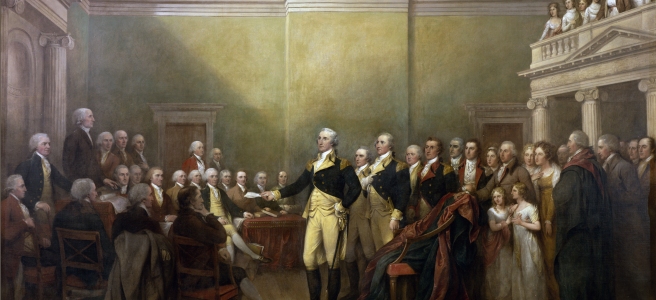At least two* significant portraits of George Washington are being auctioned this year, one by Gilbert Stuart from the Met. I was thinking of writing a lead something along the lines of “deaccessioned portrait of slave owner offered for sale.” Later in the day, President Biden gave a speech at Valley Forge, launching a campaign for his re-election, and to save democracy. At the climax, he talks about a painting in the Capitol.
I believe the painting the president referenced is General George Washington Resigning His Commission by John Trumbull. It depicts the scene on December 23, 1783, in the Maryland State House in Annapolis when George Washington resigned his commission as commander-in-chief of the Continental Army, establishing civilian authority over the military.
The president said:
“A European king at the time said after he won the revolution, now’s the time for him to declare his kingship. But instead, the mob that attacked the Capitol, waving Trump flags and Confederate flags, stormed right past that portrait. That image of George Washington gave them no pause, but it should have. The artist who painted that portrait memorialized that moment because he said it was, quote, one of the highest moral lessons ever given to the world, end of quote.”
It reminded me not to look at history through a singular contemporary lens. Washington, and his role in founding our country, are still very important and necessary to us today. It’s also important to note that at the time of Washington’s death, 317 enslaved people lived at his Mount Vernon estate, and 123 people owned by Washington himself.
It gives me a bitter taste when I hear people say “Those were different times,” or “You can’t judge another time that way.” Yes, you can. It wasn’t long after that Britain abolished slavery. There are examples of the practice being abolished going back to the 6th Century B.C. The Quakers petitioned against slavery in the colonies almost 100 years before the American Revolution. Yet Jefferson, growing up in a culture that accepted it, enslaved his own children.
If you are honest, you can’t escape it. They knew it was wrong and they did it anyway.
And so visitors to museums today have a variety of responses when looking at portraits like this.
I don’t know why the Met is selling this Vaughn portrait of Washington, but with a push to be more representational of populations, I can’t imagine there will be an institutional buyer (unless it’s one in Arkansas).
Completed in 1795 and originally owned by an English family who had supported the American Revolution, Stuart painted these repeatedly. With 14 known examples, there’s another in the Met Collection along with two in the National Gallery. No matter your thoughts on the first president, it’s a magnificent painting. You can read the whole essay here.
And that’s the thing about portraits. They of the sitter, and more than anything, it’s the sitter we see, but as one artist told me as I left with a painting I had purchased, “You bought it, but it’s never your painting. It will always be my painting.” Portraits, no matter who is depicted in them, are about the artist. Portrait painters at the time were more like craftsmen than what we think of artists today. Stuart painted Washington over and over because they were quick sales- and he could do it better than most anyone.
And if these paintings are about anything else, they are about our futile attempts at immortality. While these portraits of our first president were created because they could be sold, portraits were most often created so they could be passed down through generations with wealth. With many, if not most, portraits, we’ve lost track of the identity of the sitter or the artist. Absent that identity, they are an object in front of us, like a chair or a sideboard.
And they are a reminder that most of us, along with the good or bad that we do, will eventually be lost to history.
Although Washington arrives in the 21st century with unforgivable flaws, his role in not only our country, but in setting a historical example can be called on to help overcome the challenges we face today.
On the topic of religion, a friend shared some advice from her mother. Finding some hypocrisy in it, her mother suggested she “take out of it what you need to get out of it and leave the rest.”
With that in mind, may our first president long be remembered.
*The other portrait of Washington coming to auction is by Charles Willson Peale and is a version of the only portrait painted by Peale during Washington’s presidency. Peale of course was the patriarch of a family of important American artists and the founder of the first museum in the United States.
Discover more from Urban Art & Antiques
Subscribe to get the latest posts sent to your email.


